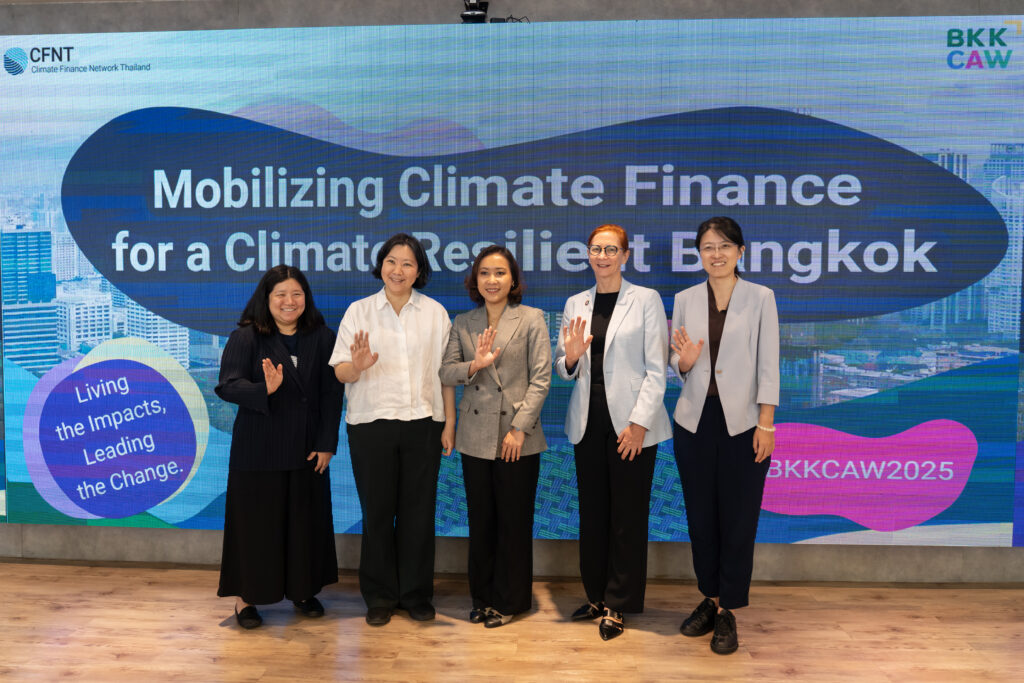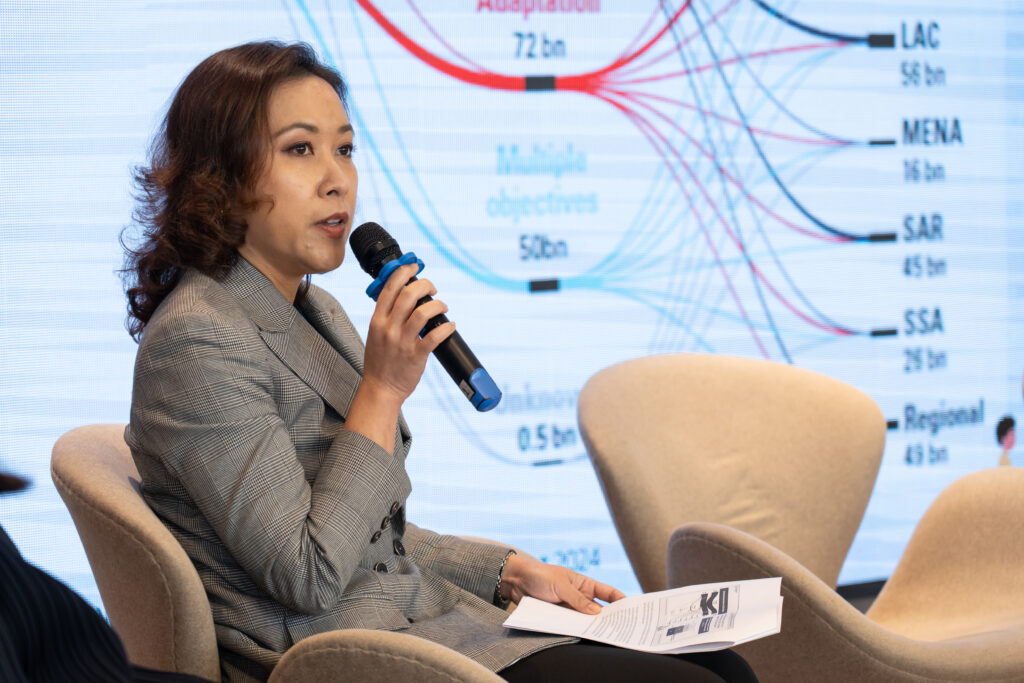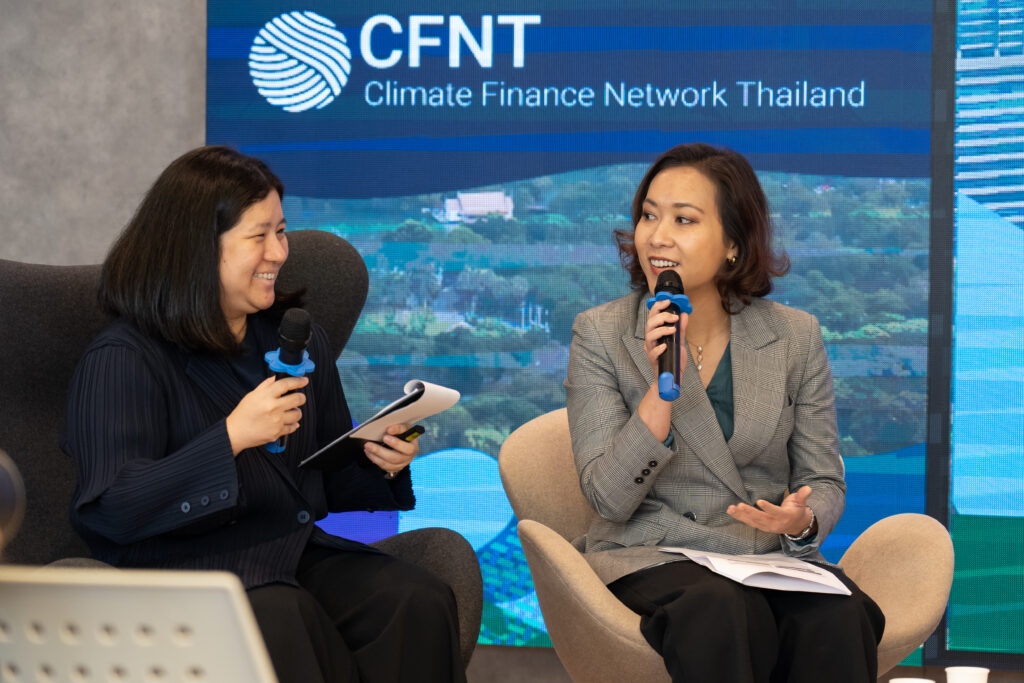
Following the presentation of ‘Thailand’s Climate Finance Landscape’ by Climate Finance Network Thailand (CFNT), a panel discussion was hosted on the topic of ‘Financing Climate Action in Bangkok –Challenges & Opportunities.’
The event featured leading international experts on climate finance, who deliberated on the key barriers to increasing climate financing, lessons learned from global experiences, and insights for strengthening resilience in Bangkok and other major Asian cities facing climate change.

Good News, Challenges, and Opportunities for Thailand – Dr. Ornsaran Manuamorn, Senior Financial Sector Specialist, World Bank
Dr. Ornsaran began by inviting the audience to take a step back and look at the bigger picture of global climate finance. She noted that the current situation presents both good news and challenges.
The good news, according to a World Bank study, is that global climate finance in 2022 reached USD1.4 trillion. This means that there are sizable global financial resources to confront the climate crisis.
However, three major challenges currently exist in the global climate finance landscape.
- Uneven Distribution of Climate Finance
Excluding China, only 14% of global climate finance currently flows to developing countries, even though these countries collectively account for 40% of global greenhouse gas emissions. - Insufficient Adaptation Finance and Overreliance on the Public Sector
Funding for climate adaptation remains far too low, representing just 16% of total domestic and international climate finance in developing economies (excluding China). Moreover, over 98% of adaptation-related finance still comes from the public sector. This indicates limited participation from private sector investors, but could also reflect current methodological difficulties in systematically tracking private adaptation investment. - Limited Climate Finance from Financial Institutions
The World Bank study estimates that by 2030, developed countries will need three times more climate finance to meet their adaptation and mitigation needs. Yet banks in developing countries—as key financial intermediaries—have provided limited climate finance so far. Currently, climate finance accounts for only 5% of total lending portfolio for nearly 6 in 10 banks surveyed by the World Bank study, with 28% of the banks providing no climate finance.
According to the World Bank’s Country Climate and Development Report, it is projected that over the next 25 years, Thailand will require approximately USD 219 billion—equivalent to 2.5% of the country’s total GDP—to effectively respond to the climate crisis. More than half of this amount, or about USD 115 billion, will need to be invested in adaptation efforts to strengthen resilience against the impacts of climate change.

Dr. Ornsaran further highlighted that Thailand can mobilize the necessary funding required to scale up investment in climate mitigation and adaptation through two key strategies:
- Green Finance. Strengthening the capacity of financial institutions to identify, manage, and assess climate-related risks, while channeling capital toward projects, technologies, and innovations that deliver positive climate outcomes.
- Unlocking new sources of capital. This includes domestic and international investments, as well as innovative financial instruments such as carbon credits.
For local and municipal governments, Dr. Ornsaran emphasized their crucial role in advancing climate-resilient investments in cities. She cited examples such as:
- Bangkok’s pioneering e-bus transaction with Switzerland—under Article 6.2 of the Paris Agreement—successfully monetized its emissions reductions and opened a path for future city-level carbon finance.
- Transport-oriented development (TOD) in major Thai cities such as Bangkok, Pattaya, and Khon Kaen, which the World Bank estimates could attract up to USD2 billion annually in investment.
- The low-carbon city development project (LCC), co-led by the World Bank and Thai government agencies, which help Thai cities, including Bangkok, invest in emissions-reducing infrastructure—such as energy-efficient buildings, rooftop solar, electric vehicles, streetlights, and improved solid waste management—while also building the systems needed to measure, aggregate, and monetize carbon credits from these investments.
“One major bottleneck in scaling climate finance is the lack of bankable and creative projects. Financiers are ready to invest and are often looking for more green assets than what is currently available. Apart from green projects in energy and transport sectors, there are many opportunities to develop low-carbon and climate-resilient projects in areas such as nature-based solutions, water management, and health-related projects to address issues like heat stress that affects both cities and people,” said Dr. Ornsaran Manuamorn, Senior Financial Sector Specialist, World Bank. “If more of these projects come on board, they will be crucial in mobilizing greater urban climate investments.”
Dr. Ornsaran concluded by reaffirming that Thailand has made substantial progress in strengthening the sustainable finance ecosystem and is, therefore, in a strong position to scale up climate finance. She also noted that the upcoming World Bank and IMF Annual Meetings 2026, to be hosted in Thailand, present an excellent opportunity for the country to demonstrate its commitment, potential, and leadership in mobilizing global climate finance towards environmentally sustainable and climate-resilient actions in cities.

Local Listening – Nikki Kemp, Executive Director, Singapore Green Finance Centre
Ms. Kemp opened her remarks by explaining her organization’s origins. Founded in 2020, the Singapore Green Finance Centre (SGFC) is a collaboration between the Singapore Management University (SMU) and Imperial College London, and is supported by the Monetary Authority of Singapore (MAS) in addition to nine leading global financial institutions. Its mission is to raise awareness of the importance of climate finance and strengthen regional cooperation in addressing climate change.
SGFC’s work currently focuses on four key areas:
- Deep financial data analysis: to track where capital is flowing, how it is being used, and which critical climate-related projects remain underfunded. This provides insights that traditional climate finance tracking tools often fail to capture.
- Building a regional knowledge hub: to consolidate, exchange, and connect climate-related data and research across sectors, thereby improving coordination and decision-making in climate action.
- Developing monitoring and evaluation systems: to measure the real-world impacts of climate investments and policy implementation.
- Driving policy engagement: through collaborations with institutions such as the Grantham Institute to develop the Climate Damage Tracker—a tool that quantifies the relationship between climate change and natural disasters, enabling more accurate assessments of economic damage and stronger evidence-based policy dialogue at national and regional levels.
Ms. Kemp likened data to both the “lifeblood” and “compass” of effective climate response—ensuring that financial flows are efficient, targeted, and impactful in reducing climate-related risks. She emphasized that this work is increasingly urgent, as global temperatures are on track to rise by up to 2.9°C, threatening severe consequences for economies, societies, and the well-being of people worldwide.
She also noted that the data clearly show that adaptation finance is fast becoming one of the most pressing concerns. According to the Climate Policy Initiative (CPI), Asia requires at least USD431 billion per year for climate adaptation. Yet, the region currently invests only USD34 billion annually—just 10% of total climate finance. Ms. Kemp further emphasized that while adaptation finance is critical, mitigation finance remains equally essential. The two are deeply interconnected and cannot be separated, as reducing emissions and strengthening resilience must advance hand in hand.
She then explained that adaptation policies are inherently local.For instance, Singapore does not face the exact same climate challenges as other countries. Therefore, climate adaptation strategies, financial mechanisms, and knowledge systems are best locally designed and driven—by the very communities that experience the impacts firsthand and best understand their own needs.
“When we talk about resilience, it is inherently local. We have to respond to the specific needs of each community. One of the guiding principles of our work in climate finance is that research and education is rooted in these local realities—not interpreted from the outside, whether that is Singapore, Bangkok, Hanoi, or London. This holds true regardless of where the capital originates,” noted Nikki Kemp, Executive Director, the Singapore Green Finance Centre.

Shared Challenges and South–South Cooperation – Guo Hongyu, Deputy Director, Greenovation Hub
Guo Hongyu, Deputy Director of Greenovation Hub (GHUB), China, began by introducing her organization. Founded in 2012 in Beijing, Greenovation Hub is an environmental research institute that tracks climate governance, energy transition, and financial regulation policies. It also supports the mobilization of finance to further international cooperation with countries in the global south, particularly in the clean energy sector.
Drawing on over a decade of research and engagement, Ms. Guo observed that many developing countries face common challenges in mobilizing climate finance, including:
- Nascent Green Finance Policies
This remains the most significant barrier. Many countries have yet to develop national green finance policies or taxonomies that define environmentally sustainable economic activities. Moreover, they often lack the financial infrastructure required to attract international investment for climate action. Even in countries that have introduced taxonomies, local governments often struggle with implementation guidelines
2. Ununified Standards and Lacking Climate Finance Data
Guo highlighted the landscape in China, where different agencies handle separate aspects of climate governance:
- The National Development and Reform Commission (NDRC) oversees greenhouse gas mitigation.
- The Ministry of Ecology and Environment manages adaptation policy.
- The People’s Bank of China and the Ministry of Finance monitor overall financial flows.
This this creates a fragmented data ecosystem, which increases coordination costs among government agencies and makes it even harder for local governments to effectively implement climate-related projects.
3. Limited Local Budgets for Climate Action
While national governments often provide subsidies or transfers to local administrative organizations, such budgets remain insufficient. As a result, local governments must seek additional sources of funding on their own. However, many struggle to do so due to various institutional and regulatory constraints, which hinder their ability to implement meaningful climate initiatives.
4. Shortage of Expertise in Climate Finance
A significant barrier also lies in the lack of financial professionals with expertise in climate-related finance at the local level. Many local financial professionals still lack knowledge in areas such as climate risk assessment and project financing for adaptation, making it difficult to design and execute viable climate projects.
Ms. Guo concluded by stressing that international cooperation is the key enabler for advancing climate adaptation projects in developing countries and with local governments. Such cooperation may include: (i) financial support, (ii) technical assistance, such as designing early warning systems, and (iii) knowledge-sharing, including tools for assessing physical climate risks and distinguishing between adaptation and mitigation projects.
“Partnerships are essential in mobilizing climate adaptation finance. The challenges are clear: a high perception of risk, limited bankable projects, difficulty in quantifying adaptation benefits compared to mitigation, and the lack of long-term climate risk data to evaluate future projects. Collaboration, especially South-South cooperation, is the key to overcoming these barriers to build a shared, climate resilient future”, explained Guo Hongyu, Deputy Director, Greenovation Hub.
Download Presentation Materials:
